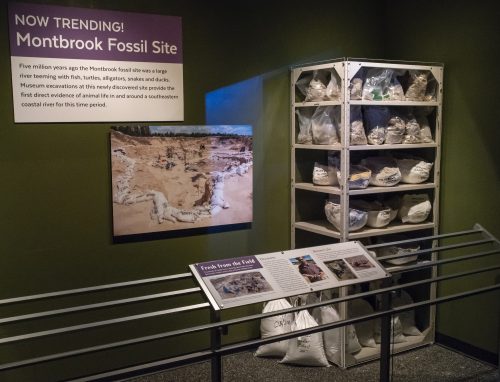GAINESVILLE, Fla. — The Florida Museum of Natural History’s “Florida Fossils: Evolution of Life and Land” exhibit now features a Montbrook showcase with more than 30 specimens from the dig site on display.

The gallery is part of a new series called “Now Trending!” which will reveal the latest research and discoveries of museum scientists and volunteers. This showcase focuses on the Montbrook site, and specifically the process of collecting and cataloging fossils to learn more about ancient environments and biodiversity.
“We are excited to have a new space to highlight current paleontology research,” said Julie Waters, Florida Museum exhibit coordinator. “The fossils currently on display are just the tip of the iceberg compared to what we have in the collections, and I hope our visitors enjoy the chance to see new specimens on display for the first time.”
Featuring new fossil discoveries, the gallery explores the meticulous effort that goes into paleontological fieldwork. Guests will see actual fossils at various stages of the collection process, from the field to the lab. The exhibit also highlights the important contributions of researchers and volunteers who work at the site, featuring photos of their discoveries along with the broader significance of these specimens.
“Everything we find at this site is valuable and interesting to us, and volunteers get to be part of actual scientific discoveries in real time,” said Florida Museum curator of vertebrate paleontology Jonathan Bloch. “This isn’t some kind of thing that’s staged for them. Almost all of our really rare, excellent fossils have been discovered by our volunteers.”
The Montbrook site, located near Williston and estimated to be about 5-5.5 million years old, is a former freshwater ecosystem full of fish, turtles, alligators and other aquatic animals. In less than three years, the site has yielded over 30,000 identifiable fossils thanks to the efforts of more than 750 people who have worked 18,000 hours on location.
For more information on the Montbrook site, visit www.floridamuseum.ufl.edu/florida-vertebrate-fossils/sites/mont.
The Florida Museum opened the “Florida Fossils: Evolution of Life and Land” exhibit in 2004. It is a free, permanent exhibit and encapsulates the last 65 million years of Florida’s history into five epochs: Eocene, Oligocene, Miocene, Pliocene and Pleistocene.
For more information on the exhibit, visit www.floridamuseum.ufl.edu/exhibits/florida-fossils or call 352-846-2000.
-30-
Writer: Nikhil Srinivasan, 352-273-2034, nsrinivasan@flmnh.ufl.edu
Source: Julie Waters, 352-273-2073, jwaters@flmnh.ufl.edu
Media contact: Paul Ramey, 352-273-2054, pramey@flmnh.ufl.edu